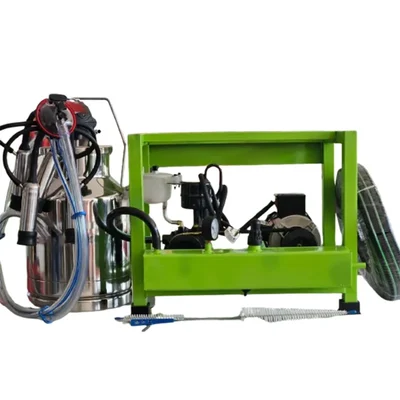- Farm & Garden
- Pumps & Motors
- Food Processing
- Workshop, DIY & MRO
- Lab & Measuring Tools

Brand: Generic ( Made in India )
Heavy Duty Single Power Single Bucket (25 L) Milking Machine With 180 LPM Pump, 1 HP Motor & 1 Year Warranty
SKU: TI-1M-44145 Delivery By: Dec 24 - Dec 26
Delivery By: Dec 24 - Dec 26 




MRP : ₹24999 ₹22049
12% OFF!
 Delivery By: Dec 24 - Dec 26
Delivery By: Dec 24 - Dec 26 
Easy Return
& Refund
& Refund

Quality
Assurance
Assurance

Trusted
Delivery
Delivery

After Sales
Assistance
Assistance

Buyer
Protection
Protection
₹22049 (Including GST)
MRP : ₹24999
12% OFF!
Get Extra ₹331 OFF on Prepaid Orders
QTY :
-
1
+
Short Description
Heavy Duty Single Power Single Bucket Milking Machine
With 180 LPM Pump, 1 HP Motor
25 Litres Stainless Steel Bucket
1 Year Warranty
With 180 LPM Pump, 1 HP Motor
25 Litres Stainless Steel Bucket
1 Year Warranty
Country of origin: India
Specifications
- Brand: Generic ( Made in India )
- Weight (Approx.) : 48.3 kg
- Material : Mild Steel
- Motor : Copper Winding (Godrej)
- Motor Power : 1 HP
- Pumping Capacity : 180 LPM
- Bucket Capacity : 25 Litres
- Frame Material : Powder Coated and Drain Valve
- Vacuum Pipe : Vacuum Pipe included
- Bucket Material : Stainless Steel
- Frame (LXWXH) (After package Dimension) : 74X46X48 Cm
- Bucket(LXWXH) (After package Dimension) : 38X38X64 Cm
NOTE : 1 YEAR WARRANTY on Motor & Pump.
Description
This 25 Liter Single Power Single Bucket Milking Machine is used by dairy farmers or individuals for extracting milk from cows. It automates the milking process, resulting in enhanced efficiency and uniformity over human milking. This machine ensures smooth, hygienic, and stress-free milking of cows or buffaloes, helping farmers save time, reduce manual labor, and improve milk yield quality. 25-liter stainless steel bucket is corrosion-resistant and easy to clean, ensuring hygiene and long-term durability. This machine is built to reduce manual labor, increase milking efficiency, and maintain milk quality.
Features
:- 25-liter stainless steel: 25-liter stainless steel bucket for hygienic and long-lasting milk collection.
- High-Performance Pump: This 180 LPM pump generates a strong and stable vacuum, ensuring effective and fast milking.
- User-Friendly Operation: Equipped with intuitive controls, the milking machine is designed for straightforward operation, reducing training time for new users.
- Automatic Milking Process: The integration of advanced technology leads to automatic milking process, reducing the time spent per cow while maximally extracting milk while maintaining the efficiency.
- Continuous Milking Operation: Powerful 1 HP motor ensuring reliable and continuous milking operation.
Accessories
:- Vacuum Pipe included: 50 Ft
- Cleaning Brush Set
Applications
:- Processing Plants: Function as part of an automated system in milk processing facilities, ensuring that the milk collected is of high quality and ready for distribution.
- Reduced Dependence On Skilled Labor: The milking machine reduces the dependence on skilled labor for milking operations, making the task more efficient and cost effective and let's anyone take control over the milking operation without the need of having the required skillset to milk a cow.
- Small Dairy Farms: Ideal for farms with a small number of cows, where manual milking is labor-intensive and time-consuming.
- Remote Locations: Its portable nature makes it useful in areas where a fixed milking parlor is not feasible.
- New Farmers: It is an excellent machine for new dairy farmers looking to automate their milking process.
Usage
:Step 1 : Prepare Your Equipment
- Cleanliness is Key : Before using the machine, ensure that all components are thoroughly cleaned and sanitized. This will help prevent contamination and maintain the quality of the milk.
- Check the Machine Properly: Inspect the electric milking machine for any signs of wear or malfunction. Ensure that all hoses are connected properly and that there are no leaks.
- Power Up: Connect the milking machine to a reliable power source. Make sure the vacuum pump is functioning correctly by turning it on and listening for any unusual noises.
Step 2 : Prepare the Animal
- Clean the Teats : Use a clean cloth or antiseptic solution to wipe down the teats. This removes dirt and bacteria, reducing the risk of contamination.
- Stimulate Milk Letdown: Gently massage the udder to stimulate milk flow and encourage letdown.
- Calm the Animal : Approach the animal calmly and ensure it is comfortable. A relaxed animal will yield better results during milking.
Step 3 : Attach the Milking Claw
- Position the Milking Claw: Hold the milking claw in one hand and align the teat cups with the animal's teats.
- Securely Attach the Cups: Gently place each teat into the corresponding cup and ensure a snug fit to create a vacuum seal.
Step 4 : Begin Milking
- Start the Machine: Once the claw is attached, turn on the milking machine. The pulsator should activate, and you should hear a rhythmic sound indicating it is working correctly.
- Monitor the Overall Process: Keep an eye on the milk flow through the transparent tubing, which allows you to see when milking is nearly complete.
- Check the Animal's Comfort: Periodically check the animal’s reaction. If they seem uncomfortable or agitated, consider stopping for a moment and readjusting the machine.
Step 5 : Finish and Clean Up
- Detach the Claw: Once the milk flow has slowed significantly, it’s time to gently detach the milking claw from the udder. Avoid pulling too hard; instead, release the vacuum first to minimize discomfort.
- Post-Milking Care: Clean the teats again with a disinfectant to prevent any potential infections.
- Empty the Milk Storage Container : Carefully pour the collected milk into a clean, sterilized container for storage or processing.
- Clean the Milking Machine: After each use, disassemble the milking machine and clean all components as per the manufacturer’s guidelines. This will extend the life of the equipment and ensure the quality of the milk.
Maintenance
- Inspect the Milking Clusters and Liners : Each day, check the milking clusters for signs of wear and tear, including any cracks or brittleness in the liners. Ensure that they are properly fitted and free from debris.
- Check Vacuum Levels : Daily checks of the vacuum system are essential. Ensure that the vacuum pressure is within the recommended range for effective milking.
- Lubricate Mechanical Parts : Regular lubrication of moving parts such as bearings and motors is essential for preventing friction and wear.
- Engage Professional Servicing: Annually, or as needed, engage a professional technician to perform a comprehensive service on the machine. This service should include checking all mechanical and electrical components, and ensuring the system operates at peak performance.

Select attribute







